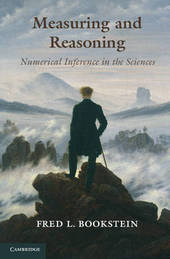
|
Measuring and Reasoning: Numerical Inference in the Sciences
Hardback
Main Details
| Title |
Measuring and Reasoning: Numerical Inference in the Sciences
|
| Authors and Contributors |
By (author) Fred L. Bookstein
|
| Physical Properties |
| Format:Hardback | | Pages:559 | | Dimensions(mm): Height 235,Width 160 |
|
| Category/Genre | Probability and statistics |
|---|
| ISBN/Barcode |
9781107024151
|
| Classifications | Dewey:001.422 |
|---|
| Audience | | Professional & Vocational | | Tertiary Education (US: College) | |
|---|
| Illustrations |
30 Halftones, unspecified; 150 Line drawings, unspecified
|
|
Publishing Details |
| Publisher |
Cambridge University Press
|
| Imprint |
Cambridge University Press
|
| Publication Date |
28 February 2014 |
| Publication Country |
United Kingdom
|
Description
In Measuring and Reasoning, Fred L. Bookstein examines the way ordinary arithmetic and numerical patterns are translated into scientific understanding, showing how the process relies on two carefully managed forms of argument: * Abduction: the generation of new hypotheses to accord with findings that were surprising on previous hypotheses, and * Consilience: the confirmation of numerical pattern claims by analogous findings at other levels of measurement. These profound principles include an understanding of the role of arithmetic and, more importantly, of how numerical patterns found in one study can relate to numbers found in others. More than 200 figures and diagrams illuminate the text. The book can be read with profit by any student of the empirical nature or social sciences and by anyone concerned with how scientists persuade those of us who are not scientists why we should credit the most important claims about scientific facts or theories.
Author Biography
Fred L. Bookstein is Professor of Statistics at the University of Washington, Seattle; Professor of Morphometrics, Faculty of Life Sciences, University of Vienna, Austria; and an emeritus Distinguished Research Professor at the University of Michigan. Since 1977 he has produced some 300 books, chapters, articles, and videotapes on various aspects of these methods and their applications in studies of normal and abnormal craniofacial growth in humans and other mammals, studies in the neuroanatomy and behavior of schizophrenia and fetal alcohol spectrum disorders, and evolutionary studies of hominids and ammonoids. He is especially interested in how statistical diagrams can convey the valid numerical patterns that characterize complicated systems like continental drift or fetal alcohol brain damage to the broad modern public. The figures in this book include many of his current favorites along these lines.
|